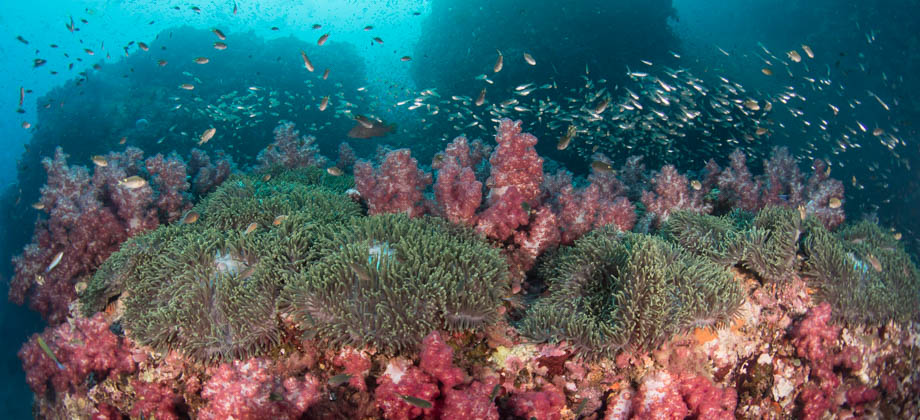December 25, 2021
Posted by Ramon Fadli in Diving, Islands, IUCN Protected Category 2, National Parks, Phang Nga, Reefs, Thailand, Tropical Coral Reefs, Tropical Monsoon
Similan Islands
Similan Islands - Part 1 : Similan Islands
Similan Islands - Part 2 : Hunting Schools
Similan Islands - Part 3 : Colours & Shades
Similan Islands

of formations that divers can expect to find at some of the dive sites that surround
the Similan Islands. The short walk up to this rock will also reward you with some
panoramic views that look over Donald Duck Bay

Overcrowding
These islands and their white, sandy beaches are sometimes sensationally referred to as 'secret' or are 'unexplored', but this is very far from the truth. Day trips by speedboat from Phuket and other nearby regions such as Krabi and Ao Nang are very common, and they shuttle large swarms of thousands of tourists to the islands on a daily basis. These boats tend to be small vessels and are quite often crammed to the brim, so they can be a very unpleasant ride when the sea gets even a little bit choppy. The day trip packages normally include a pickup directly from the hotel in Phuket and the two-hour or so shuttle to the pier at the small fishing village of Thap Lamu. For scuba divers, the best and by far the most rewarding choice is a liveaboard. Sleeping on the boat means that your first dive of each day is shortly after sunrise, and your last not too long after sunset, which means that up to four dives can be squeezed into each day. When this post was written, there were roughly three to four boats even at the most popular sites, but apparently there had been many times that number in pre-pandemic times. The sheer number of tourists that have visited the area in the past has certainly left a toll. So much so that the government of Thailand has had to take several steps to not only allow the area to recover, but perhaps also to increase the chances of their planned 2022 UNESCO heritage site bid:
- All the islands are closed to tourists during the Monsoon season, from May to October
- Islands 1-3 are off-limits due to turtle nesting sites and reef conservation efforts
- Ko Tachai is closed to tourists indefinitely, although scuba diving around the island is allowed
- There is no longer any overnight accommodation on any of the islands
- The limit of day trip tourists is now 3325 people per day
- The limit of scuba divers on liveaboards is now 525 people per day
- Camping on any of the islands is prohibited. The only way you can sleep in the national park is on a liveaboard
- Fishing is prohibited in both Similan and Surin National Parks

Diving Similan
The dive season in the Similan islands usually runs from November to April, which is essentially the entire dry season. However, later on from February to April, nutrient-rich upwellings cause plankton blooms, which unfortunately do reduce the visibility, but also tend to attract much larger filter feeders--the manta rays (Manta spp.) and whale sharks (Rhincodon typus). These gentle giants are normally seen much further north of the Similan Islands, at Ko Bon, Ko Tachai, and Richelieu Rock--all dive sites where the currents tend to be stronger. Don't fret, however, if the gentle giants remain elusive, as there is plenty of other marine life to enjoy. The ubiquitous granite formations around the islands make the underwater landscapes very dramatic. Steep valleys, pinnacles, and swim-throughs are covered with all manner of bright and colourful coral. Fields of table coral, staghorn coral, and the occasional giant barrel sponge (Xestospongia testudinaria) are interspersed around numerous bommies, whilst enormous Gorgonian sea fans (Gorgonia spp.) are found at the dive sites that have stronger currents. Some sites, like those found at Ko Tachai, can have swirling, omni-directional currents, and the sea fans there appear almost mutated, as their parallel layers of growth face several different directions.
Nearest Hyperbaric Chambers
Hyperbaric Services, Patong : (076) 342518 Vachira Hospital, Phuket City : (076) 211114 Bangkok Phuket Hospital, Phuket City : (076) 254421Interactive Location Map


cleanerwrasse (Labroides dimidiatus) can be seen cleaning the gills of the individual
at the back. An oriental sweetlips (Plectorhinchus vittatus) and an Andaman
sweetlips (Plectorhinchus macrospilus) can also be seen
Next : Hunting Schools
Thailand Overview





